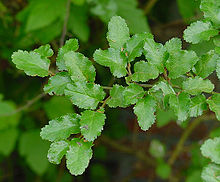Antarctic beech
| Antarctic beech | ||||||||||||
|---|---|---|---|---|---|---|---|---|---|---|---|---|

Antarctic beech ( Nothofagus antarctica ) |
||||||||||||
| Systematics | ||||||||||||
|
||||||||||||
| Scientific name | ||||||||||||
| Nothofagus antarctica | ||||||||||||
| ( G.Forst. ) Oerst. |
The Antarctic beech ( Nothofagus antarctica ), also known as the Antarctic southern beech or Penny Beech , is a deciduous tree from the genus of the beech ( Nothofagus ) in the family of the beech family (Nothofagaceae) within the order of the beech-like (Fagales).
description
Vegetative characteristics
The Antarctic beech is an upright, often multi-stemmed tree and can reach heights of up to 35 meters. The treetop is open and irregular. The bark is covered with eye-catching cork pore bands. The branches are arranged like a herringbone and the bark is covered with light-colored cork pores. The bark of young twigs is bare, green and reddish on top.
The alternate, two lines and very densely arranged on the branches leaves are divided into petiole and leaf blade. The simple leaf blade is egg-shaped to broadly egg-shaped with a length of 1.5 to 3 centimeters with a truncated to heart-shaped blade base and a rounded upper end. The leaf margin is fine and irregularly serrated. There are four to six pairs of nerves. The upper side of the leaf is glossy dark green and glabrous, the lower side is slightly hairy on the central nerve.
Generative characteristics
The Antarctic beech is single-sexed ( monoecious ).
The fruits stand in groups of three in a four-lobed fruit cup .
The number of chromosomes is 2n = 26.
Occurrence
The Antarctic beech is found in southern Argentina and central and southern Chile. There it grows in cool, moist forests on permeable, fresh to moist, acidic to neutral, sandy to sandy-humic, moderately nutrient-rich soils . It thrives best in sunny locations and loves warmth and is only moderately frost hardy .
Systematics and research history
The species Antarctic beech ( Nothofagus antarctica ) belongs to the subgenus Nothofagus from the genus of the beech ( Nothofagus ). The genus Nothofagus are the only genus of the (therefore monogeneric ) family Nothofagaceae. The first publication took place in 1789 under the name ( Basionym ) Fagus antarctica by Forster . The new combination to Nothofagus antarctica (G.Forst.) Oerst. was published by Oersted in 1871 .
The generic name Nothofagus is derived from Fagus “beech” and from the Latin expression “nothus” for “fake” but also “illegitimate”. The name was introduced by Blume and refers to the small differences between false beeches and beeches. The specific epithet antarctica also comes from the Latin and means "south". It refers to the occurrence in the southern hemisphere. (The Latin word "antarcticus" is therefore not congruent with the German expression "Antarktisch", which only describes the area south of the southern polar circle .)
In addition to the type species, the variety Nothofagus antarctica var. Uliginosa A.DC. distinguished, the leaves of which are short, fine and upright hairy on both sides.
use
The Antarctic beech is used as an ornamental plant.
proof
literature
- Andreas Roloff , Andreas Bärtels: Flora of the woods. Purpose, properties and use. With a winter key from Bernd Schulz. 3rd, corrected edition. Eugen Ulmer, Stuttgart (Hohenheim) 2008, ISBN 978-3-8001-5614-6 , p. 430.
- Schütt, Schuck, Stimm: Lexicon of tree and shrub species . Nikol, Hamburg 2002, ISBN 3-933203-53-8 , pp. 315 .
- Jost Fitschen: Woody flora . 12th, revised and expanded edition. Quelle & Meyer, Wiebelsheim 2007, ISBN 3-494-01422-1 , p. 613-614 .
- Helmut Genaust: Etymological dictionary of botanical plant names. 3rd, completely revised and expanded edition. Nikol, Hamburg 2005, ISBN 3-937872-16-7 (reprint from 1996).
Individual evidence
- ↑ Schütt et al .: Lexicon of Tree and Shrub Species, p. 315
- ↑ a b Fitschen: Gehölzflora , p. 614
- ↑ a b Roloff et al .: Flora of the Woods , p. 430
- ^ Nothofagus antarctica at Tropicos.org. In: IPCN Chromosome Reports . Missouri Botanical Garden, St. Louis
- ↑ Rafaël Govaerts (Ed.): Nothofagus - World Checklist of Selected Plant Families of the Royal Botanic Gardens, Kew. Last accessed on January 15, 2017.
- ^ Paul S. Manos: Systematics of Nothofagus (Nothofagaceae) based on rDNA Spacer Sequences (its): Taxonomic Congruence with Morphology and Plastid Sequences. (pdf; 211 kB) (No longer available online.) In: American Journal of Botany 84 (9). 1997, pp. 1137–1155 , formerly in the original ; accessed on February 26, 2011 (English). ( Page no longer available , search in web archives ) Info: The link was automatically marked as defective. Please check the link according to the instructions and then remove this notice.
- ↑ Nothofagaceae. In: Germplasm Resources Information Network (GRIN). United States Department of Agriculture, accessed February 26, 2011 .
- ^ Fagus antarctica. In: Germplasm Resources Information Network (GRIN). United States Department of Agriculture, accessed February 26, 2011 .
- ↑ a b Nothofagus antarctica. In: Germplasm Resources Information Network (GRIN). United States Department of Agriculture, accessed February 26, 2011 .
- ↑ Exactly: Etymological Dictionary of Botanical Plant Names , p. 423
- ↑ Exactly: Etymological Dictionary of Botanical Plant Names , p. 65
Web links
- Nothofagus antarctica. Chilebosque, accessed February 26, 2011 (Spanish).
- Thomas Meyer: Data sheet with identification key and photos at Flora-de: Flora von Deutschland (old name of the website: Flowers in Swabia ).



